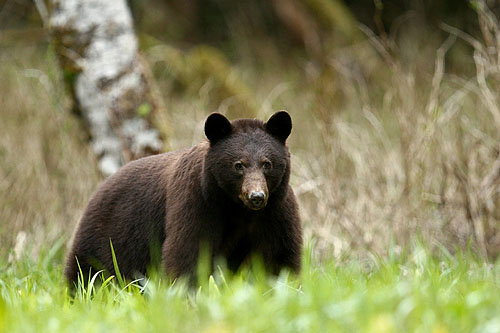Spot andStalk Black Bear Hunting
Spring black bear season is fast approaching, so today I’d like to offer my top 10 tips for bagging a black bear spot-and-stalk style.
When I first started bear hunting back in 2012, I studied everything I could find on black bears. I also spoke to several biologist to learn more about bears and habitat. Interestingly, much of the theoretic data I collected proved wrong. For instance, one article stated that early morning was the least productive time to spot bears. But in my experience I saw just as many bears early as late. One biologist mentioned that bears absolutely hate the rain, but I ended up shooting my first bear in a steady rain storm. Go figure.
Ultimately, spot-and-stalk archery success comes from boots on the ground and relentless real-life experience. The following are the most important lessons I learned when hunting bears early on.
Spot and Stalk Black Bear Top 10 Tips:
1. Food is Everything: Someone once said that black bears are just big hairy pigs. They eat, dig, and root around constantly, rarely holding still for very long. Since they’re so distracted, it should make them easy to hunt, right? Kinda. Like deer, bears feed for a while, then bed down for a few hours and repeat. The good news is that bears are easy to spot and generally found out in the open.

Spring bears primarily feed on new grass shoots, wild onions, clover, dandelions, and other spring offerings. It is imperative to talk to your regional biologist to find out what the bears are primarily feeding on in your area.

As for time of day, my advice is to hunt bears like deer: Get to a high vantage before first light and start glassing steep, grassy, south-facing slopes adjacent to old-growth forest (used for bedding). Of the nine bears I encountered last year, most were spotted in the early morning or late afternoon.
Even in the best units, you’ll likely glass many miles before actually seeing a bear. If you can’t glass up a bear, keep moving. Get away from busy roads, explore remote canyons, and cover as much ground as possible. Bears are solitary animals and are spread out across their range. This leads to tip #2.
2. Look for Sign: If glassing fails, the next step is to locate an area that looks “beary” and look for sign. You’re looking for large piles of black or green dropping, claw marks on trees, tree trunks rubbed smooth with hair attached, dirt diggings, tracks in mud, turned over logs and other items, and dug-in tracks (see photo below). I’ll break these things down separately as we go, but basically you’re just looking for concentrations of bear sign and focusing your efforts there.
The most common sign you’ll encounter is droppings, aka scat. Droppings come out wet and green, then quickly oxidize to black (within 12 hours in warm weather). If you’re not finding droppings, keep moving.

3. Examine the Trees: An area dense with claw-marked trees is a good indication of a likely bear hang-out. Black bears–especially cubs–like to climb trees which leaves claw marks in the bark.
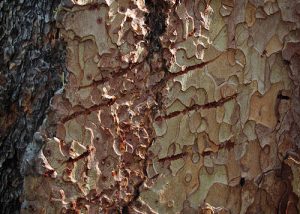
Bears also rub on trees just like deer, and they always have their favorite rub tree. Rub trees occur near trails or bedding areas and are generally conifers with easily identifiable, smooth spots with hair stuck to it.

4. Watch for Tracks: Unlike deer, bear leave few tracks because their foot pads are wide and soft which spreads their weight out. Most bear tracks are found in snow, mud, or soft dirt.
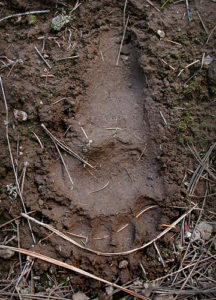
Another strange phenomon I found was “dug-in” tracks. Dug-in tracks are frequently found near bedding areas. Rather than soft tracks, these are trails that bears use every day while traveling from feed to bed. Because they step in the exact same spots it creates staggered depressions in the ground. (see photo below)
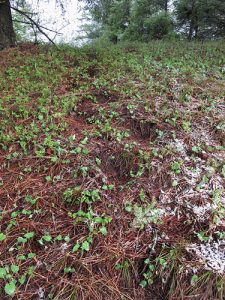
Bear tracks will help you judge the size of a bear. Basically the main pad (front or back) of a mature bear (sow or boar) will be 4.5 inches or wider. Sow tracks generally don’t get bigger than 4.5″, but a big boar will stretch up to five or six inches.
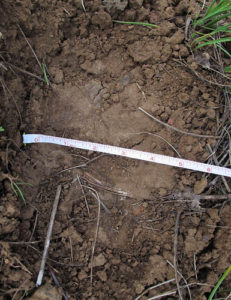
5. Locate Bedding Areas: Bear beds are similar to deer beds and are usually located in thick stands of trees not far from feeding areas. Bear beds often look like large nests, where the bear pushes branches and ground cover to the outer edges of the bed. Bears also like to bed on the cool, dark north-face slopes near the tops of ridges. Also, just about every bed I found had multiple piles of scat nearby.
6. Watch for Items Turned Over: What the heck does that mean? Rocks, logs, and cow pies turned upside-down. This is something I never read, but everywhere I found bears or bear sign I found multiple items turned over. A rock lying next to a depression in the ground where it previously lied is most common. In springtime, bears are primarily herbivores, but they really love protein from insects, grubs, mice, and other animals hiding underground. You’ll also encounter occasional diggings. Diggings consist of a random two or three-foot holes dug into the dirt where the bear went after a squirrel or other animal.
7. The Triple “S” of Bear Behavior: Secretive, Shy, and Slippery: Assuming you’ve found a good feeding area with lots of sign, there’s still no guarantee you’ll find a bear. On several of my hunts I found areas littered with bear sign, but no bears anywhere.
Bears are slippery! They have a bad habit of disappearing right in front of you. They mosey behind a tree and they’re suddenly gone from the world. They are such quiet animals and chronically secretive. They are very shy and secretive because they simply don’t want to be found.
Being patient is the key to bear success. When a bear finds a good feeding area/hillside, he’ll likely stay on it for several days. If you’re in a good location, or if you glassed up the bear earlier in the day, he’ll likely re-appear sooner or later in the same general area.
8. Watch the Nose: Bear hunting is technically easier than deer hunting because unlike deer, bears have relatively poor hearing and eyesight. However, the bear’s nose is equal to or better than a deer’s nose. Simply put, if he smells you it’s game over, so always hunt according to wind direction. Be sure to use a windicator often when searching for or stalking bears.
Note: Bears have short attention spans. If a bear sees or hears you, hold very still and he’ll likely forget you were there.
9. Watch the Weather: Just like deer, bears avoid heavy rain or snow. However, a light rain doesn’t seem to bother them. Hungry bears will happily brave the elements… and bears are always hungry! In my experience rain was not a factor, but snow and freezing temps were real bad news.
On two separate occasions I spotted a bear one day, and when the snow moved in, it disappeared from the mountain. This is especially a problem in the early season (April and May) when the bears are living close to their dens. When the snow flies, they head back to their dens and won’t emerge again until the weather gets better. It’s much easier for them to just go back to bed and wait for brighter days.
10. Know the Anatomy: Unlike hooved animals, bears carry their vitals (heart/lungs) further forward in their chest. When a bear is broadside the front shoulder blocks the vitals. Therefore, you must time your shot for when the front leg is moving forward. I learned this the hard way by trying to squeeze an arrow too tight to the shoulder. My arrow hit the bear’s big, powerful shoulder which stopped my arrow short of the vitals. Fortunately he swung around to face me and my second arrow sailed under it’s chin and into the chest. He didn’t go too far, but I was lucky. Fortunately bears don’t react the same way as deer; they’re more likely to stay put after a poor shot instead of instinctively sprinting away.
Conclusion
I hope you found these tips helpful for your spot-and-stalk bear hunt. I realize that the majority of bear hunters prefer using dogs and/or bait, but in my experience there’s nothing more exciting. challenging, or rewarding than getting it done on the ground the old-fashioned way.
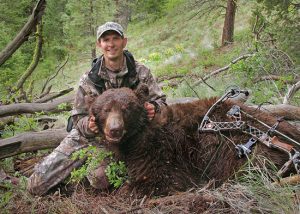
Good luck, and be careful out there!

